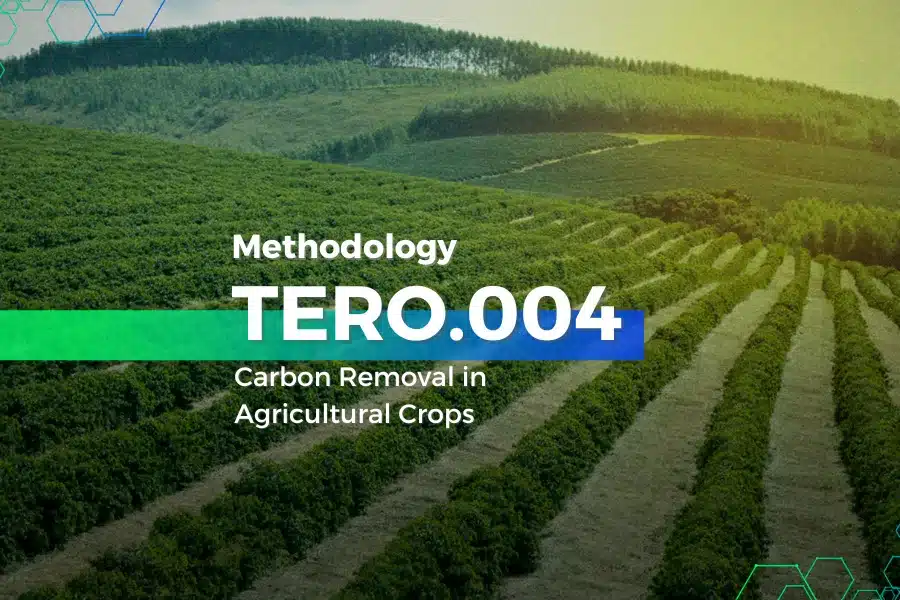TERO.004 – Carbon Removal in Agricultural Crops Methodology
This methodology provides the technical guidelines for AFOLU sector projects that promote carbon sequestration through biomass accumulation in long-lived crops. Developed to ensure integrity, additionality, and permanence, it offers a robust pathway for generating Verified Carbon Units (VCUs) based on sustainable agricultural practices.
Why choose TERO.004?
Focus on Agricultural Systems
Designed specifically for carbon sequestration in the biomass of perennial and semi-perennial crops, such as coffee, cocoa, fruit production, and non-timber agroforestry systems.
Strong Scientific Foundation
Quantification is based on inventory practices and allometric equations aligned with IPCC guidelines, ensuring technical robustness and credibility of the generated credits.
Permanence Guarantee
As a carbon removal methodology, the Buffer Reserve (BR) mechanism is mandatory to mitigate reversal risks and ensure the environmental integrity of the assets.
Is Your Initiative Eligible?
This methodology applies to projects involving perennial or semi-perennial crops that result in atmospheric carbon removal and meet the following criteria:
✅ Land Tenure Compliance: The project is implemented on rural properties with verified land tenure regularity.
✅ Generates Socio-Environmental Impacts: Demonstrates at least two socio-environmental co-benefits in addition to carbon removal.
✅ Proves Additionality: The activity produces a positive environmental impact, demonstrating additionality.
✅ Has Appropriate Land Use History: The area was not classified as “forest” within 5 to 10 years before project initiation (unless it is the reforestation of a degraded area).
Applying the Methodology
Your journey from project design to credit generation follows a logical process. Each stage requires the use of specific Tero Program tools to ensure accuracy and auditability.
Step 1: Baseline, Additionality, and Leakage
In this phase, you establish the reference scenario, demonstrate project additionality, and assess emission displacement risks.
- Baseline: Establish the pre-existing biomass carbon stock (if any) according to the procedures in Section 3.4 of this methodology.
- Additionality: Demonstrate that the project is additional using the Project Additionality Demonstration Tool (FR.CER.003).
- Leakage: Assess and quantify leakage risk using the Leakage Assessment and Management Tool for NBS VCU Projects (FR.CER.005).
Step 2: Quantification and Permanence Guarantee
This is the core stage, where carbon removals are calculated and the safeguard mechanism is applied.
- Stock Quantification: Use the Technical Guidelines for Carbon Quantification in AFOLU Projects (DC.CER.003) to estimate the biomass carbon stock of your crop.
- Net Removals Calculation: Calculate net removals adjusted for leakage according to the equations in Section 3.7.1 of this methodology.
- Risk and Buffer Pool (BP): Assess the Non-Permanence Risk (NPR) using Tool FR.CER.004 and apply the mandatory Buffer Reserve mechanism.
Step 3: Monitoring and Reporting
Continuous monitoring forms the basis for periodic verifications. The Monitoring Plan must be detailed in your Project Design Document (PDD).
- Carbon Monitoring: Track biomass parameters (DBH, height, etc.) and other emission sources as described in Section 4.1 of this methodology.
- Risk Monitoring: Continuously monitor internal and external risk factors identified in the NPR analysis.
- Monitoring Report: For each verification period, submit a full report following the requirements of Tool FR.CER.007.
Essential Documentation: TERO.004
Here you will find the main methodology document and the models directly associated with its application.
Main Document
TERO.004 – Carbon Removal in Agricultural Crops, v2.1 (PT) (EN)
The complete document with all guidelines for carbon removal projects in agricultural systems.
Developed by:
Key Tools and Models
- FR.CER.003 – Project Additionality Demonstration Tool
- FR.CER.004 – Non-Permanence Risk Analysis and Guarantee Mechanism Tool
- DC.CER.003 – Technical Guidelines for Carbon Quantification in AFOLU Projects
Revision History
To ensure full transparency, a public record of all previous versions of this methodology is maintained.
Version 2.0 (Date: 04/02/2025)
Commitment to Transparency and Civil Society Participation
Share your Concerns or Suggestions
Do you have any concerns or suggestions about any of our registered Programs or Projects?
Submit your claims anonymously and help us continually improve.
We aim to lead the certification of Brazilian assets for the global market
Ready to learn more about our certification services or need detailed information about our service fees? Contact us today and start turning your environmental impact into value.
